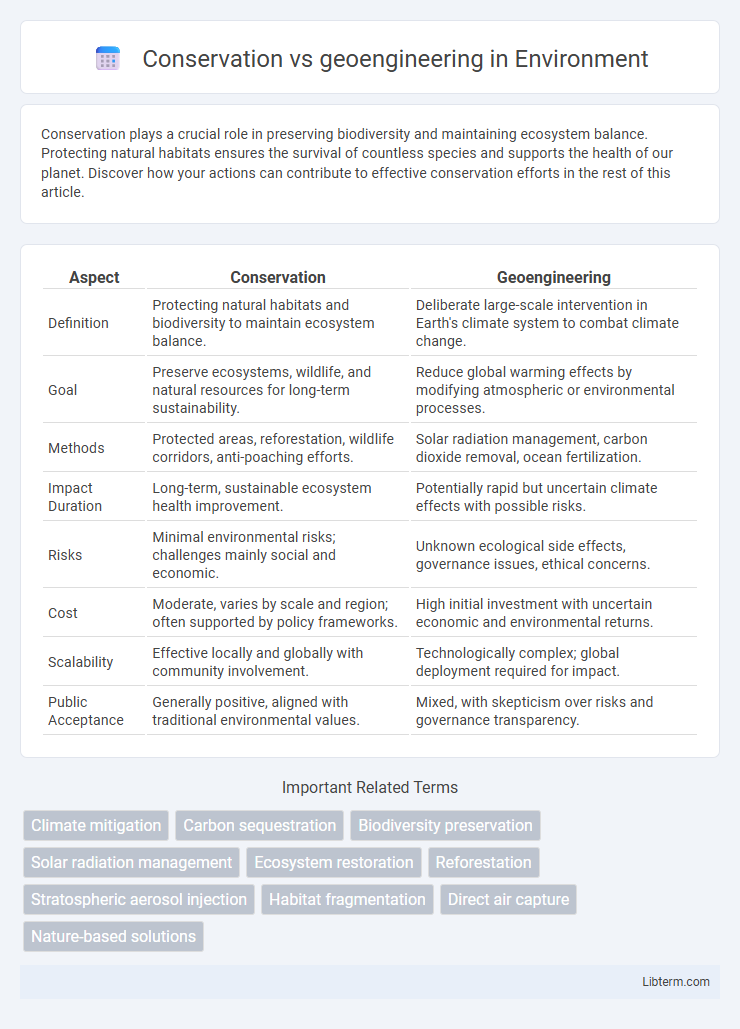Conservation plays a crucial role in preserving biodiversity and maintaining ecosystem balance. Protecting natural habitats ensures the survival of countless species and supports the health of our planet. Discover how your actions can contribute to effective conservation efforts in the rest of this article.
Table of Comparison
| Aspect | Conservation | Geoengineering |
|---|---|---|
| Definition | Protecting natural habitats and biodiversity to maintain ecosystem balance. | Deliberate large-scale intervention in Earth's climate system to combat climate change. |
| Goal | Preserve ecosystems, wildlife, and natural resources for long-term sustainability. | Reduce global warming effects by modifying atmospheric or environmental processes. |
| Methods | Protected areas, reforestation, wildlife corridors, anti-poaching efforts. | Solar radiation management, carbon dioxide removal, ocean fertilization. |
| Impact Duration | Long-term, sustainable ecosystem health improvement. | Potentially rapid but uncertain climate effects with possible risks. |
| Risks | Minimal environmental risks; challenges mainly social and economic. | Unknown ecological side effects, governance issues, ethical concerns. |
| Cost | Moderate, varies by scale and region; often supported by policy frameworks. | High initial investment with uncertain economic and environmental returns. |
| Scalability | Effective locally and globally with community involvement. | Technologically complex; global deployment required for impact. |
| Public Acceptance | Generally positive, aligned with traditional environmental values. | Mixed, with skepticism over risks and governance transparency. |
Understanding Conservation: Principles and Practices
Conservation emphasizes preserving biodiversity through sustainable management of natural resources, habitat protection, and restoration efforts to maintain ecological balance. Key principles include minimizing human impact, supporting native species, and promoting ecosystem resilience to climate change. Effective conservation practices involve protected areas, community engagement, and adaptive management based on scientific monitoring.
Geoengineering Explained: Tools for Climate Intervention
Geoengineering involves deliberate large-scale interventions in Earth's climate system to counteract global warming, utilizing methods such as solar radiation management and carbon dioxide removal. Techniques like stratospheric aerosol injection aim to reflect sunlight and lower temperatures, while ocean fertilization promotes carbon sequestration through enhanced biological activity. Unlike conservation, which focuses on preserving ecosystems, geoengineering offers technological approaches to directly modify climate dynamics and mitigate climate change impacts.
Comparing Environmental Impact: Conservation vs Geoengineering
Conservation efforts prioritize preserving natural ecosystems and biodiversity, reducing carbon emissions through sustainable land management and habitat restoration, which promotes long-term ecological balance. Geoengineering techniques, such as solar radiation management or carbon dioxide removal, aim to mitigate climate change rapidly but carry risks of unintended consequences, including disruption of weather patterns and ocean chemistry. The environmental impact of conservation is generally more predictable and beneficial for ecosystem health, while geoengineering remains experimental with potential for both large-scale benefits and hazardous side effects.
Cost-Benefit Analysis of Conservation and Geoengineering
Cost-benefit analysis of conservation highlights long-term ecosystem resilience, biodiversity preservation, and sustainable resource use with comparatively low financial investment. Geoengineering projects involve high upfront costs, technological risks, and uncertain climate impacts but offer rapid mitigation potential against global warming. Evaluating both approaches requires balancing immediate climate intervention benefits against ecological sustainability and economic feasibility.
Ethical Considerations in Climate Strategies
Conservation efforts prioritize preserving natural ecosystems and biodiversity, emphasizing ethical stewardship and intergenerational equity in climate strategies. Geoengineering poses ethical challenges related to unintended environmental impacts, governance, and equitable decision-making among global populations. Balancing conservation with geoengineering requires transparent risk assessment and inclusive policies to uphold environmental justice and moral responsibility.
Long-Term Sustainability: Which Approach Prevails?
Conservation prioritizes preserving natural ecosystems to maintain biodiversity and ensure long-term environmental stability, while geoengineering proposes large-scale technological interventions to counteract climate change effects. Evidence suggests conservation offers more sustainable outcomes by fostering ecosystem resilience and reducing carbon emissions at their source. Geoengineering carries risks of unintended ecological consequences, making conservation the prevailing approach for long-term sustainability.
Risks and Uncertainties of Geoengineering
Geoengineering presents significant risks and uncertainties, including potential disruptions to regional climates, unforeseen ecological impacts, and challenges in governance and global cooperation. Unlike conservation, which enhances natural ecosystems and biodiversity resilience through proven methods, geoengineering techniques such as solar radiation management carry the risk of abrupt climate changes if terminated abruptly. The lack of comprehensive long-term studies and monitoring frameworks heightens concerns about the unintended consequences and ethical implications associated with large-scale geoengineering deployment.
Societal Roles: Community Engagement in Conservation
Community engagement in conservation fosters local stewardship and empowers residents to actively protect biodiversity and ecosystems. Participatory conservation initiatives enhance social equity by incorporating indigenous knowledge and addressing community-specific environmental challenges. Effective engagement strengthens societal resilience against climate change impacts through collaborative decision-making and sustained environmental education.
Policy and Governance: Regulating Climate Solutions
Effective policy and governance frameworks are essential to balance conservation efforts and geoengineering technologies in climate solutions. Regulatory measures must address risks, ethical considerations, and transparency to ensure responsible deployment of geoengineering while safeguarding biodiversity and ecosystem integrity. International cooperation and adaptive governance models are critical to harmonize standards, monitor impacts, and enforce accountability in both conservation initiatives and geoengineering applications.
Integration or Opposition: Finding a Balanced Path Forward
Conservation efforts emphasize preserving natural ecosystems and biodiversity, while geoengineering proposes large-scale technological interventions to mitigate climate change impacts. Integrating these approaches requires carefully balancing the ecological risks of geoengineering with the proven benefits of conservation to enhance climate resilience. Opposing perspectives highlight the need for stringent ethical frameworks and adaptive governance to ensure geoengineering complements rather than undermines long-term conservation goals.
Conservation Infographic

 libterm.com
libterm.com